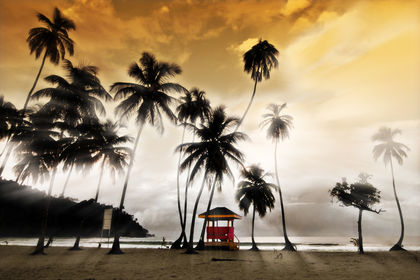Trinidad and Tobago - Poverty and wealth

Distribution of wealth has always been uneven in Trinidad and Tobago. Although there is a large middle class, there are also extremes of wealth and poverty. The wealthy minority is made up of those with interests in private-sector manufacturing and, it is widely rumored, with good contacts in politics and the state corporations. There is a small elite descended from the traditional plantation owners, often light-skinned and educated abroad, but there is also a larger group of entrepreneurs, many of whom owe their fortunes to the boom years of the 1970s when land prices rocketed and money flowed freely. Another wealthy group is comprised of business people of
| GDP per Capita (US$) | |||||
| Country | 1975 | 1980 | 1985 | 1990 | 1998 |
| Trinidad & Tobago | 3,302 | 4,615 | 4,731 | 4,095 | 4,618 |
| United States | 19,364 | 21,529 | 23,200 | 25,363 | 29,683 |
| Venezuela | 4,195 | 3,995 | 3,357 | 3,353 | 3,499 |
| St. Lucia | N/A | 2,076 | 2,150 | 3,542 | 3,907 |
| SOURCE: United Nations. Human Development Report 2000; Trends in human development and per capita income. | |||||
| Distribution of Income or Consumption by Percentage | |
| Share: Trinidad and Tobago | |
| Lowest 10% | 2.1 |
| Lowest 20% | 5.5 |
| Second 20% | 10.3 |
| Third 20% | 15.5 |
| Fourth 20% | 22.7 |
| Highest 20% | 45.9 |
| Highest 10% | 29.9 |
| Survey year: 1992 | |
| Note: This information refers to income shares by percentiles of the population and is ranked by per capita income. | |
| SOURCE: 2000 World Development Indicators [CD-ROM]. | |
East Indian origin who have set up lucrative operations in the retail and import-export sectors. The richest citizens of Trinidad are to be seen in the hillside suburbs of Port of Spain, where large villas boast satellite dishes and swimming pools. Trinidad and Tobago's rich tend to live a transnational lifestyle, with assets and interests in the United States. Shopping trips to Miami or Caracas are commonplace, and some upper-class families prefer to send their children abroad for education rather than to the local University of the West Indies.
The other extreme is to be found in deprived inner-city ghettos such as Laventille, where the poorest members of society live. It is here, in areas of ramshackle shacks and self-built cinder-block houses, that the worst problems of poverty, unemployment, and crime grow unabated. Unemployment is worst among the 15-19 age group, of whom an estimated 43 percent are out of work. This has contributed to an alarming rise in violent crime, much of it connected with drugs and gang warfare. The other areas of greatest deprivation are small villages, often inhabited by agricultural laborers of Indian descent, around the central sugar belt.
Trinidadian society is not hugely stratified on color lines, although there is often considerable tension between the African-and Indian-descended sectors of the community. Social mobility is possible, but there is often little opportunity for poor families to improve their economic outlook other than through migration.
Despite areas of poverty, health care and education are generally of a high standard in Trinidad and Tobago, especially in the urban areas. Primary education is free and compulsory, and there is a high level of literacy, estimated by the Pan-American Health Organization at 95 percent. Secondary school enrollment, beginning at 12, is also free, but only 69 percent of eligible children were enrolled in 1999. Social security is extremely basic, and much of the care of the old and sick is entrusted to family networks or charitable agencies.
| Household Consumption in PPP Terms | |||||||
| Country | All food | Clothing and footwear | Fuel and power a | Health care b | Education b | Transport & Communications | Other |
| Trinidad & Tobagao | 20 | 10 | 23 | 5 | 13 | 7 | 22 |
| United States | 13 | 9 | 9 | 4 | 6 | 8 | 51 |
| Venezuela | 30 | 6 | 17 | 16 | 13 | 7 | 12 |
| St. Lucia | 40 | 5 | 11 | 4 | 17 | 11 | 11 |
| Data represent percentage of consumption in PPP terms. | |||||||
| a Excludes energy used for transport. | |||||||
| b Includes government and private expenditures. | |||||||
| SOURCE: World Bank. World Development Indicators 2000. | |||||||
It has been a stronghold of the PNM fordecades,who over the years relied on the solid support of the community, but has failed to help these people from their deprived state of existence.
It is sometimes reffer to as a no go area.
The area is in dire need of enviromental upgrade,better housing and employment,bettereducational facilities and compassiom.
These people are at the mercy of the highly educated uncaring politicians ,the rich and the masterminds of crime. They need urgent long term financial and welfare help.